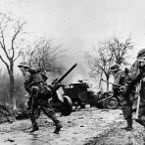simovitch
Posts: 5488
Joined: 2/14/2006
Status: offline

|
Following up on some discussions regarding Leadersdhip and Command Ratings over at the IWGC boards, to wit:
quote:
1. Having a high Leadership rating (A, B) really only benefits the rally attempts of very low quality (Q=3-4) troops. In other words, an "F" Leader will provide the same benefit to the rally attempt of a Q=5-9 unit that an "A" Leader would.
Example:
Wellington is an L=5, or "B" leader. He provides a +1 to the morale of any unit with Q=4-9, +2 for Q=3, +3 to Q=2, etc.
Colonel Anonomous is an L=1, or "F" leader. He provides a +1 to the morale of any unit with Q=1-9.
What this means is that since most of the units that come into play have Q>3 anyway, the Leadership rating is a rather insignificant value in the game.
2. Command Rating effectiveness (the ability to Reform) depends a lot on how high up the command chain is represented in a scenario. In smaller scenarios where a Division commander is the highest Org level on the map, the units will be at a disadvantage. The best DR modifier they can hope to get is -2, and that in turn will be tougher to get without the other -2 modifiers normally passed down from Corps and Wing/Army during the Command check.
This is a case where scenario designers may want to give the Division and Brigade Leaders a higher command rating to compensate for the lack of a higher Org. But they will still never get that juicy -4 modifier possible if an Army or Wing commander is on board. Or would it make sence to include the Army and Corps commander on the map, even though historically they may have been several miles away and completely detached from the battlefield, except by using runners?
I've been experimenting with "Courier" units to fill in the Command chain in the smaller, corps and division sized scenarios where the army or corps leader was not historically present. This allows the possibility of passing on the benefit of the Army/Corps Command Rating to the on board Divisional Leader.
In this screenshot, the Courier unit represents Napoleon's influence on Lannes Corps during the attack on Saalfeld, October 10, 1806:

 Attachment (1) Attachment (1)
_____________________________
simovitch
|
 Printable Version
Printable Version















 New Messages
New Messages No New Messages
No New Messages Hot Topic w/ New Messages
Hot Topic w/ New Messages Hot Topic w/o New Messages
Hot Topic w/o New Messages Locked w/ New Messages
Locked w/ New Messages Locked w/o New Messages
Locked w/o New Messages Post New Thread
Post New Thread